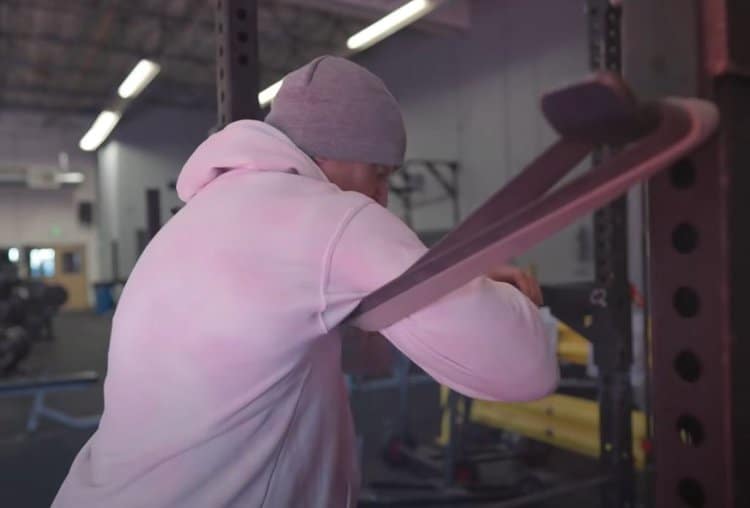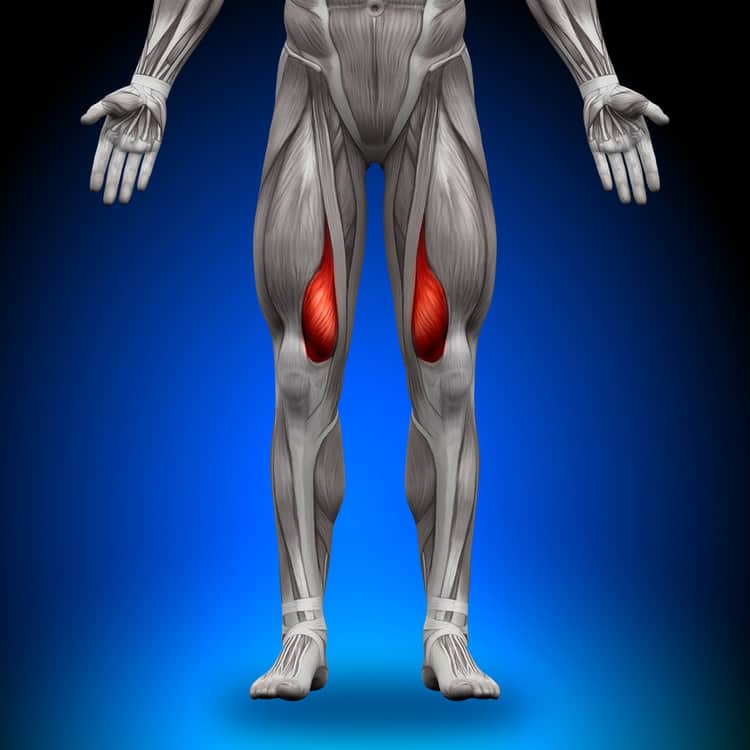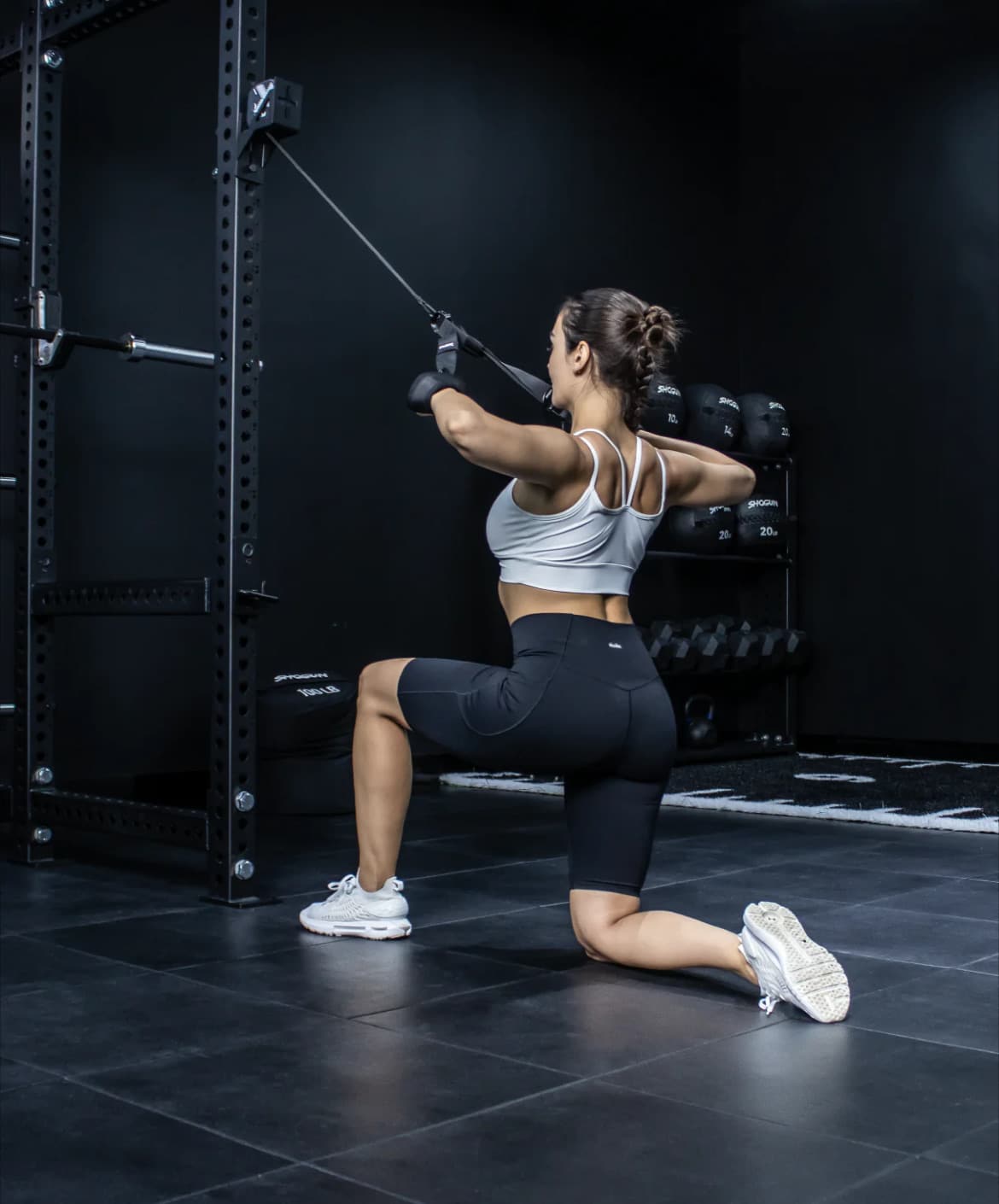Discovered by Mark Bell in collaboration with Ben Patrick, the teardrop squat has become an absolute staple in my own leg workouts and one of my all-time favorite knees over toes exercises.
This extremely unique movement simultaneously maximizes knee flexion while minimizing joint discomfort due to the resistance band element.
In this article I’m going to summarize the benefits of the teardrop squat, and we’ll also discuss proper form so you can give it a whirl next time you train legs!
How To Perform The Teardrop Squat
You’ll need access to a power rack with J hooks for this movement.

You could probably make do with a squat rack, but it will need to be quite stable since you’re hanging a chunk of your bodyweight off it.
You’ll also need a resistance band that matches the level of assistance you’ll need when doing the movement.
Any reasonably sized resistance band should do the trick for most athletes.
Attach the resistance band around both J hooks, so the band is where the barbell would usually be.

While standing on the balls of your feet, grab ahold of the resistance band and slowly descend down into the squat while maintaining a perfectly upright back.
Your objective is to sink down so that you’re bum is touching your heels.
Here’s a clip of me doing a few this a few weeks ago!
*Note: Although it felt extremely natural at the time, my form’s definitely a little off here…
You should stay up on the balls of your feet at all times and don’t try to stand all the way up!
Depending on your level of mobility, you might not be able to reach bum-to-heel level depth like Ben can, but that’s the goal.

When you’re in the super deep state of knee flexion, you’re relying almost exclusively on your VMO (teardrop muscle) to pull you out of the hole, which is where it gets its name.
With the assistance of the resistance band, squat yourself out of the hole and you’ve completed 1 rep.
The key to these is to not release tension at the bottom of the rep and also to avoid standing all the way up.
Try to keep your VMO activated throughout the entire movement and you’ll start to notice the burn especially in this muscle.
Teardrop Squat Sets & Reps
Ben Patrick’s recommendation is to perform 25-50 reps of the teardrop squat.
Depending on your current level of knee mobility and whether you’re experiencing any discomfort, you might want to scale that back quite a bit.
A few sets should be plenty to get some good knee adaptation happening.
Let’s quickly summarize some regressions you can do to alter the level of difficulty of this movement…
Teardrop Squat Progressions
I strongly recommend warming up with a bit of a sled workout prior to doing these, as it’ll get your tendons loosened up and blood flowing into the muscles surrounding the knee.
Most athletes should have no issues performing the teardrop squat if they’re adequately warmed up, but if you’re struggling, you can make the movement a little easier for yourself with the following regeressions.
1. Band Under Armpit
The easiest variation of the teardrop squat is to start with the resistance band hooked under your armpits.

You might find this is a little too awkward so it’s completely fine to skip this one.
2. Band At Chest Level
The next easiest way to do the teardrop squat is to start with the resistance band at around chest level.
Naturally, this reduces your bodyweight at the bottom of the hole and allows you to control how much pressure is hitting that knee joint.
3. Band At Head Level
Once the above is too easy, you can hold the resistance band around your head/neck area.
Eventually you’ll just be using the band as a guide and not using it so much for assistance at all!
4. Freak Level – Unassisted
With enough teardrop squats, you should eventually be able to perform this exercise completely unassisted.
This is a very long way off for the majority of athletes, but definitely something to work towards!
Why The Teardrop Squat Is So Effective
The major issue most people have with reaching a full knee bend is that they feel like their knees are going to explode…
The teardrop squat effectively reduces your bodyweight which allows you to get into deep knee flexion without putting too much pressure on the joint.
Let’s take a closer look at why I love this exercise.
Strength At Length!
Why would you care to reach full knee flexion anyway?
Strengthening your quads in a fully lengthened position is going to help with all sorts of athletic movements that will carry over to the court, track, or field.
It’s The Perfect Sissy Squat Regression
If you’re looking for a sissy squat alternative, or something that’s a little easier to start with, the teardrop squat is ideal.
This movement replicates a very similar range of motion to what we see in the sissy squat, and it’s significantly easier to perform.
It Drives Bloodflow To The Tendons
Perhaps the best thing about the teardrop squat is the knee health gains you’re going to make from it.
The extreme range of motion forces your tendons to develop and the VMO stimulus will also help protect your knee from chronic injuries like patella tendonitis.
VMO Isolation
Any bodybuilders out there?
We used to think it was impossible to isolate the VMO, but that was based upon research where the range of motion used was only 90 degrees…
You’ll find that the teardrop squat, because of its absurd range of motion, does an impeccable job of targeting the VMO, virtually exclusively.
When you’re in that bum-to-heel position, you’re relying almost entirely on your VMO to get you out of the hole.
Not only is this great for athletes who want to develop some sexy looking teardrop muscles, but it’s useful from a prehab perspective too…
According to Ben Patrick, the ratio of your VMO to other quad muscles correlates with how injury resistant you’ll be, so strengthening those VMOs is going to be great for longevity.
No Load Required!
You probably could eventually do this movement with an additional load, but the whole point of the teardrop squat is that we’re reducing the load by using the resistance band.
This makes it relatively seamless to throw into your regular leg workout.
Teardrop Squat: Muscles Worked
The primary muscle worked in the teardrop squat is the vastus medialis obliquus AKA your VMO which is the teardrop shaped quad muscle on the inside of your knee…

You will also feel this movement throughout the rest of your quads, particularly your vastus lateralis (outer head), but the vast majority of the work being done is from the VMO.
Conclusion
The teardrop squat is one of my new favorite ways to safely get my knees used to full flexion.
It’s helped me a get rid of a lot of discomfort I was feeling during sissy squats as well!
My knees feel a lot more healthy now that I’m doing a few sets of these twice a week.
If you haven’t already given it a go, I’d highly recommend it!























